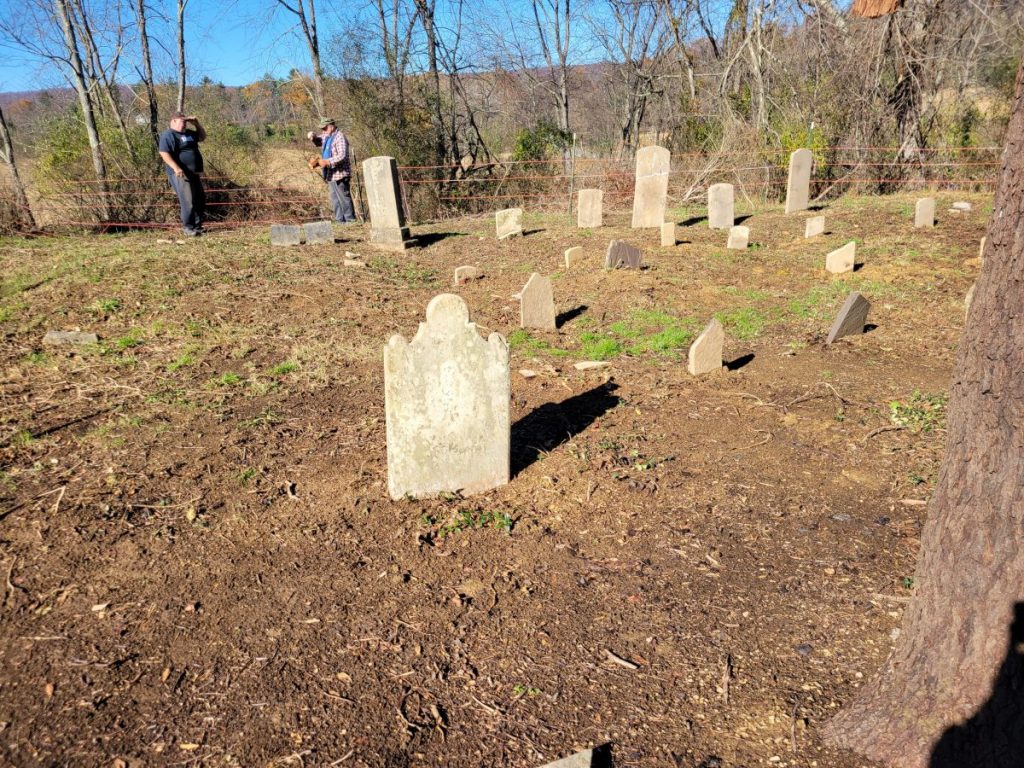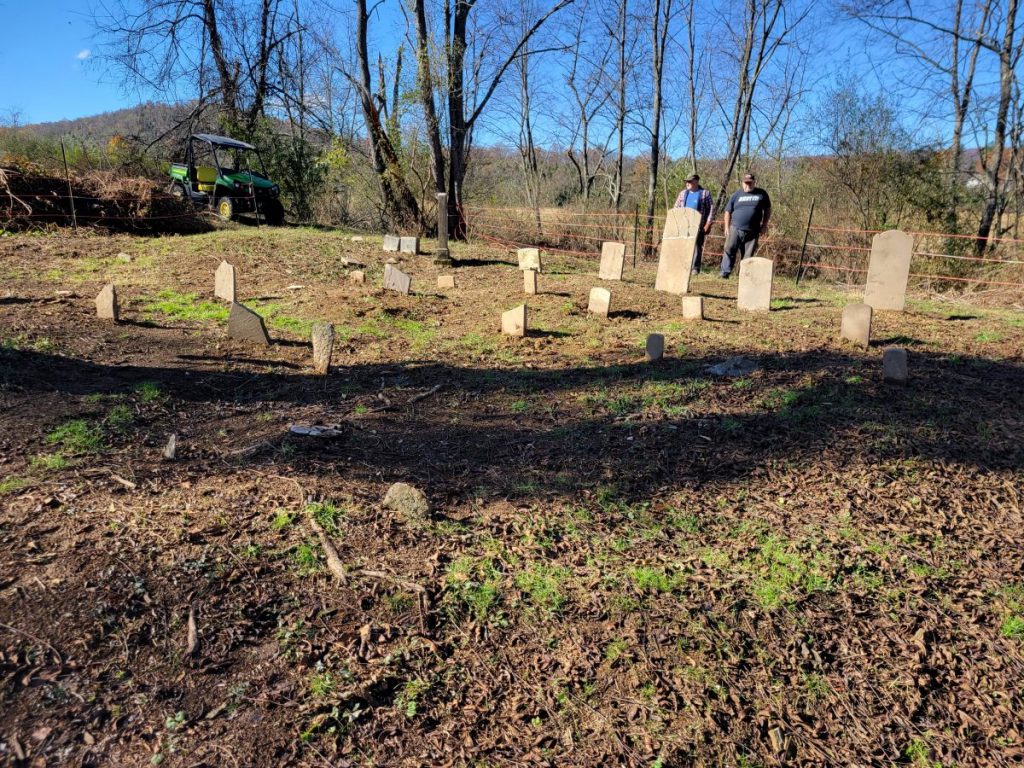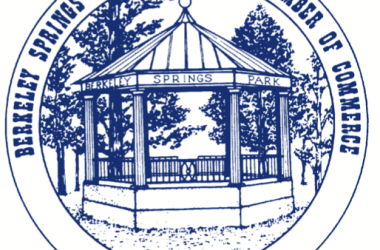by Geoff Fox
Sitting above Western Pike, about three miles west of Hancock, sits a small graveyard known as the Dillon Farm Cemetery. Its stones date back to the 18th and 19th century. Over the years, it had been overgrown with brush, with and cows walking through the graves.

Charles “Pickle” Diehl and Ronald Michael stand along the fence line of the Dillon Cemetery. Both men cleared the vegetation and debris from around the graves and set stone up correctly.
That is until Charles “Pickle” Diehl went looking for it. With help from family members, friends, and David Smith, Diehl cleared the brush and set stones back upright.
Of the graves, there are 20 that are known, but there are some that have been lost to history. Over 200 years, names have been worn away by the elements.
Diehl was born and raised on the orchard in the area, and his home place was just over the hill behind the cemetery.
He had always been told about a cemetery being in the orchard, so he and his nephew decided to look for it.
When they couldn’t find it, Diehl said Smith told them he’d help.
Before Smith got involved, Diehl said he and his nephew would carry their tools up the hill from the road. A trail can be seen from National Pike going up the hill.
They ended up clearing the cemetery by hand, but it got too much work, and Diehl couldn’t handle the walking.
Smith then came in and put a small road in where they could get a John Deere Gator up to the cemetery.
Brush had grown up around the graves and most were on the ground. Only three gravestones were visible when Diehl first got to the cemetery. A Jacob Reel and two other stones, names worn off, stood in plain sight.
“We brought the Gator up here and we started clearing off more, put the fence up, set the stones up, everything to make a cemetery look nice for old as it was,” he said. Some stones were repaired.
There are some tombstones in the cemetery, but some of those buried there couldn’t afford a tombstone at the time, so they were only left with a random stone as a foot or headstone.
Overall, it took about three or four weeks for Diehl and Ronald Michael, his nephew, to clear everything and get the fence up.
Diehl said he was surprised the dates on the stones went back as far as they did.
“I knew they was old, but I didn’t know back in the 1700s,” he said.
Diehl said he took the interest in cleaning the cemetery up and enjoyed doing so.
He said members of the Historical Society know about the cemetery and had been out there and were surprised about the find as well.
Diehl said he contacted a Reel family member in Hancock to let them know about the cemetery.
Tracy Salvagno traveled to the graveyard. Salvagno said she was contacted by someone at Fairview Orchards about a month ago and knew she had been looking for the cemetery. They told her Diehl had found the cemetery and gave her his contact information.
When she contacted Diehl, Salvagno said she was already in her car with her gloves and bag full of tools.
The two met and did a little work at the cemetery.
“It was sort of shocking almost,” Salvagno said.
She mentioned the work of Samuel W. Piper who went through Washington County, documenting every name on every tombstone in every cemetery within the county.
In Hancock alone, there were 25 cemeteries, which included three in Fulton County. The R.S. Dillon Farm cemetery is the one Diehl found.
When looking online, there are about 20 names listed as being buried in this cemetery. Salvagno said working in the area, she could tell there were more than that.
In his writings, Piper noted “lot of other graves, plain stones” on the list of names.
“There are other graves that have been marked just with a field stone that don’t necessarily have an inscription,” Salvagno said.
She said it was interesting to see that and just how quickly the cemetery grew over with trees, vines and brush.
“Those guys really worked hard getting a lot of that stuff cleared out,” Salvagno said.
By the time she arrived, there was an open space but they kept finding stones on the edges of where they’d already cleared.
It was one of the best days she’d had in a while, she said.
“It’s silly to be excited about a cemetery, but it was just so interesting and just kind of thinking of the history of Hancock and all,” she said noting the age of the headstones.
One of the first headstones they found was that of Abraham Nicodemus, which they could read by using a flashlight and the shadows to clearly read the name.
This cemetery is known as the R.S. Dillon Cemetery but there are no Dillons buried there. The name comes from the Dillon Orchard Company which owned the property at the time when Piper made his report.
Salvagno thinks the unmarked stones could have been someone who couldn’t afford an actual gravestone, or the resting place of a slave.
Salvagno said St. Thomas Episcopal Church that could have information of people who were buried in this particular cemetery.
One was a man who was a freed slave from another farm who might be buried in the cemetery. In the church records, there’s a mention of Elisha Miles, who is buried there. His headstone is still visible.
“I’m not sure that there’s really any way ever to prove that, but I think that it kind of shows that it’s more than likely that some of those plain stones are marking the graves of enslaved people,” she said.
There was one stone that read “IN MEMORY” with a backward “N.” That stone made an impact on Salvagno.
“It just struck me how much care someone had taken, and obviously didn’t have the resources to have a professional carver engrave a cut stone, but found a stone and put that inscription on it,” she said. “It touched me so much because the cemetery was just so overgrown and his thoughtfulness was almost forgotten, so it was nice to kind of bring that back.”
While it won’t tell much about the formation of the town, Salvagno said by looking at some of the records connected to the names, it could tell about the use of slave labor, economy, why people came to Hancock, and things like that.
“I don’t yet know all that might come to light as a result of finding the cemetery but there is a wealth of information on the stones that we can read,” she said. “I’m sure we will learn some interesting things.”
The known names buried in the cemetery are, according to findagrave.com: Barbara Slagle Miles (?-1885), D. Miles (unknown), Jacob S. Miles (?-1843), Abraham Nicodemus (1802-1836), Francis Thomas Reel (?-1859), J.L. Reel (1849-1850), Jacob Reel (?-1874), David Sheppard (1793-1864), John Sheppard Sr. (?-1857), William Sheppard (1800-1870), Daniel Shlageal (?-1861), Daniel M. Shlageal (?-1862), Elizabeth Shlageal (1781-1855), Jacob Shlageal (?-1857), Mary M. Shlageal (1778-1823), Jacob Shlageal (1806-1881), John Slagle (?-1812), Oddie Slagle (unknown), Willie Slagle (unknown), and Philip Young (1818-1840), Elisha Miles (1798-186?).

Overgrown with vegetation, you couldn’t tell this was a cemetery except for the headstone sticking up. Photo by Ronald Michael.







